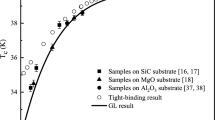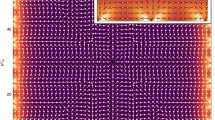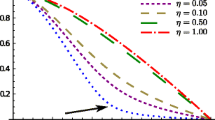Abstract
The healing of two-band superconductivity near its interface is studied. It is demonstrated that the restoration of superconductivity gaps in the immediate vicinity of the interface is governed by two length scales: the first one diverges at critical temperature T c , while the second one diverges at T c+<T c . By moving away from the boundary, the temperature dependencies of characteristic lengths change so that singularity at T c+ becomes removed in the bulk by arbitrary weak interband coupling. The asymptotes for the spatial behavior of gaps have been found analytically near the surface and approaching the bulk state.
Similar content being viewed by others
Avoid common mistakes on your manuscript.
1 Introduction
Spatial correlations belong to the most important properties of superconducting systems. Very unconventional features of coherency were found recently in magnetic response of multi-band compounds [1–6]. The various aspects of spatially inhomogeneous multi-gap superconducting ordering were studied in Refs. [3, 7–15].
Coherence lengths for two-band superconductivity were first obtained almost 30 years ago by means of the two-component Ginzburg-Landau equations [16]. It was shown that the spatial variations of superconductivity gaps are determined by the mixture of coherency modes characterized by qualitatively different length-scales: conventional (critical) one which diverges at phase transition temperature and unconventional (non-critical) one which stays finite. The dependencies of the contributions of coherency modes on the parameters of the system and temperature were analyzed in Ref. [17].
Probably the most natural way for the determination of coherence lengths is the calculation of relevant correlation functions. The intra- and interband spatial correlation functions of two-band superconductivity, derived in Ref. [15], contain critical and non-critical coherence lengths. The spatial behavior of fluctuations in a bulk two-band superconductor is characterized by length-scales which coincide with the coherence lengths [17]. In the present paper, we want to find out what happens with characteristic length-scales if two-band superconductivity is distorted by the presence of the interface.
2 Basic Equations
We consider the weak coupling s-wave superconductivity in a system with two partially overlapping bands. It is supposed that the superconducting ordering is created by the intraband effective electron-electron attractions with constants W 11,22<0 and by interband pair-transfer interaction with the constant W 12 = W 21. These interaction channels are supposed to be operative in the energy layer \(\pm \hbar \omega _{c}\) around the Fermi level intersecting both bands.
The spatially inhomogeneous two-band superconductivity is described by the appropriate free energy functional following from the BCS-type microscopic theory. In the absence of magnetic field, it reads as [18]
Here, α=1,2 is the band index, ρ α are the densities of electron states at the Fermi level per one spin direction, δ α are the non-equilibrium superconductivity gaps, and coefficients are given by
where \(g=\ln \left [1.13\hbar \omega _{c}/(k_{\mathrm {B}}T)\right ]\) and w α α = W α α ρ α and \(w_{12}=w_{21}=W_{12}\sqrt {\rho _{1}\rho _{2}}\) are the dimensionless interaction constants forming a 2×2 matrix \(\hat {w}\). We assume clean limit where bands are characterized by the Fermi velocities v Fα .
Due to the surface, equilibrium superconductivity gaps vary with the distance x from the boundary. By using an ansatz \(\delta _{\alpha }(x)=\left |{\Delta }^{\infty }_{\alpha }\right |f_{\alpha }(x)\mathrm {e}^{i\phi _{\alpha }}\), where \(\left |{\Delta }^{\infty }_{\alpha }\right |\) are the modula of gaps in the bulk homogeneous state, and taking constant phases ϕ α , the minimization of the free energy functional (1) leads to the following differential equations
where
Here, we have taken into account the bulk relation between the sign of interaction constant w 12 and the difference of phases ϕ 1−ϕ 2. If interband interaction channel is absent, i.e., Ξ12=Ξ21=0, the system (3) splits into two equations for independent bands.
The system of non-linear differential (3) must be solved numerically. For the sake of simplicity, we will use the first-type homogeneous boundary conditions at the surface, f α (0)=0. The situation can be achieved by means of a ferromagnetic film coating the surface of a superconductor [19]. Far from the boundary f α =1 and \(f_{\alpha }^{\prime }=0\).
3 Length-Scales Near the Surface and Near the Bulk Superconducting State
Characteristic length-scales for superconductivity manifest themselves in the asymptotic behavior of gap functions. Close to the boundary, we linearize (3) as follows:
where \(\gamma ^{2}_{\alpha }=\beta _{\alpha }/a_{\alpha }\). Near the bulk superconducting state, we consider small deviations 𝜖 α =1−f α which satisfy
where \(\xi ^{2}_{\alpha }=\beta _{\alpha }/A_{\alpha }\) and \(A_{\alpha }=a_{\alpha }+3b\left |{\Delta }^{\infty }_{\alpha }\right |^{2}\).
The temperature dependencies of the reciprocal values of the coefficients \(\xi _{1,2}^{2}\) and \(\gamma _{1,2}^{2}\) are shown in Fig. 1. One can see that in the superconducting state (T<T c ) the quantities \(\xi _{\alpha }^{2}\) are always finite and positive, while \(\gamma _{\alpha }^{2}\) change their signs at the certain temperatures passing through infinity. This difference is one of the reasons for the modification in the characteristic length-scales near the surface compared to the region far from it.
If interband interaction is switched off, w 12=0, the quantities ξ 1 and ξ 2 transform into coherence lengths for corresponding independent bands with autonomous superconducting phase transitions at the critical points T c1 and T c2,
At the same time, the quantities γ 1 and γ 2 coincide with ξ 1 and ξ 2 in the regions T≥T c1 and T≥T c2, respectively.
The general solution of the system (5) has the following form:
where K α± are constants and
The solutions (8) satisfy the boundary conditions chosen.
One easily finds (see also Fig. 2) that
Here,
with \(\chi ^{\pm }=\text {tr}\hat w\pm \sqrt {(\text {tr}\hat w)^{2}-4{\det }\hat w}\). The inequality \(T_{c}^{+}<T_{c}^{-}\) is always valid. For vanishing interband interaction \(T_{c}^{-}\rightarrow T_{c1}\) and \(T_{c}^{+}\rightarrow T_{c2}\), if T c1>T c2. The dependencies of \(T^{\pm }_{c}\) on the constant of interband interaction are depicted in Fig. 3. If interband interaction is sufficiently strong, \(w^{2}_{12}\geq w_{11}w_{22}\), the temperature \(T_{c}^{+}\) disappears.
The quantities \(\gamma _{\pm }^{-2}\) vs temperature for |w 12|=0.001. Rest parameters are given in the caption of Fig. 1
The dependencies of \(T^{\pm }_{c}\) on the interband interaction constant. Rest parameters are given in the caption of Fig. 1
By taking into account (10), the asymptotes near the surface take the following form
Approaching the bulk state, the solution of the system (6) yields
where
are the coherence lengths of a two-gap superconductor [11, 15].
The coefficients \(C_{\alpha \pm }^{0}\) and \(C_{\alpha \pm }^{\infty }\) in the expressions of the asymptotes (12–-14) can be determined by using the fitting to the exact solutions found numerically.
It is seen from (12) and (13) that one must consider the modula |γ ±| as characteristic length-scales near the surface. At the same time, according to (14), the coherence lengths ξ ± play the role of length-scales as one is approaching the bulk superconducting state. The functions |γ ±(T)| and ξ ±(T) exhibit different temperature dependencies, see Figs. 4 and 5. Both |γ −| and ξ − diverge at T c , but at \(T^{+}_{c}\) only the length |γ +| is singular, while ξ + remains finite everywhere. In Figs. 4 and 5, one can observe how the curves |γ ±(T)| and ξ ±(T) change with the variation of the strength of interband interaction in comparison with the functions |γ 1,2(T)| and ξ 1,2(T) taken for the condensates in non-interacting bands.
The temperature dependencies of length-scales near the surface (upper panel) and far from the surface (lower panel) for |w 12|=0.001. Upper panel: |γ −(T)|—thick solid line, |γ +(T)|—thin solid line; dotted and dashed lines represent the dependencies |γ 1(T)| and |γ 2(T)|, correspondingly, in the case w 12=0. Lower panel: ξ −(T)—thick solid line, ξ +(T)—thin solid line; dotted and dashed lines represent the dependencies ξ 1(T) and ξ 2(T) correspondingly for w 12=0
The temperature dependencies of length-scales near the surface (upper panel) and far from the surface (lower panel) for |w 12|=0.007. The functions depicted are the same as in Fig. 4
We notice that coherence length is a characteristic of bulk state so that |γ ±| cannot be treated as coherence lengths. Therefore, the singularity of |γ +| at \(T_{c}^{+}\) is not related to any phase transition unless w 12=0.
In Fig. 6, an example of the asymptotes calculated by means of (12) (upper panel) and by means of (14) (lower panel) have been presented compared to exact dependencies f 1,2(x). The coefficients \(C_{\alpha \pm }^{0}\) and \(C_{\alpha \pm }^{\infty }\) were found by fitting to the numerical solutions of non-linear equations providing matching with exact curves in remarkably wide domains.
The dependencies of f 1,2 on x. Dashed-dotted linesin the upper panel: asymptotic behavior of f 1,2(x) near the surface. Dotted lines in the lower panel: asymptotic behavior of f 1,2(x) near the bulk superconducting state. Solid lines represent the exact dependencies f 1,2(x) calculated numerically. Parameters: \(w_{11}=-0.25, w_{22}=-0.26, |w_{12}|=0.003, \hbar \omega _{c}=0.05 \, eV, v_{F1}=5\times 10^{5} \, m/s, v_{F2}=5.2\times 10^{5} \, m/s, T=0.9T_{c}>T_{c}^{+}\)
4 Conclusion
We have found that the recovery of two-gap superconductivity suppressed by the surface of a sample is described by the linear combination of two spatial modes characterized by length-scales which diverge at different temperatures \(T_{c}^{\pm }\). Approaching the bulk superconducting state, the singularity at \(T_{c}^{+}\) disappears and the length-scales become equal to the coherence lengths in a macroscopic two-band superconductor.
References
Babaev, E., Speigh, M.: Phys. Rev. B 72, 180502 (2005)
Moshchalkov, V., Menghini, M., Nishio, T., Chen, Q.H., Silhanek, A.V., Dao, V.H., Chibotaru, L.F., Zhigadlo, N.D., Karpinski, J.: Phys. Rev. Lett. 102, 117001 (2009)
Carlström, J., Babaev, E., Speight, M.: Phys. Rev. B 83, 174509 (2011)
Garaud, J., Babaev, E.: Phys. Rev. B 86, 060514 (2012)
Ray, S.J., Gibbs, A.S., Bending, S.J., Curran, P.J., Babaev, E., Baines, C., Mackenzie, A.P., Lee, S.L.: Phys. Rev. B 89, 094504 (2014)
Vinnikov, L.Ya., Artemova, T.M., Veshchunov, I.S., Zhigadlo, N.D., Karpinski, J., Popovoch, P., Sun, D.L., Lin, C.T., Boris, A.V.: JETP Lett. 90, 299 (2009)
Babaev, E., Carlström, J., Speight, M.: Phys. Rev. Lett. 105, 067003 (2010)
Silaev, M., Babaev, E.: hys. Rev. B 84, 094515 (2011)
Komendova, L., Milosevic, M.V., Shanenko, A.A., Peeters, F.M.: Phys. Rev. B 84, 064522 (2011)
Silaev, M., Babaev, E.: Phys. Rev. B 85, 134514 (2012)
Örd, T., Rägo, K., Vargunin, A.: J. Supercond. Novel Magn. 25, 1351 (2012)
Litak, G., Örd, T., Rägo, K., Vargunin, A.: Acta Phys. Pol. A 121, 747 (2012)
Komendova, L., Chen, Y., Shanenko, A.A., Milosevic, M.V., Peeters, F.M.: Phys. Rev. Lett. 108, 207002 (2012)
Litak, G., Örd, T., Rägo, K., Vargunin, A.: Physica C 30, 483 (2012)
Vargunin, A., Örd, T.: Phys. Rev. B 86, 104506 (2012)
Poluektov, Y.M., Krasilnikov, V.V.: Fizika Nizkih Temperatur 15, 1251 (1989)
Örd, T., Vargunin, A., Rägo, K.: Physica C 495, 217 (2013)
Zhitomirsky, M.E., Dao, V.-H.: Phys. Rev. B 69, 054508 (2004)
Ketterson, J.B., Song, S.N.: Superconductivity. Cambridge University Press, Cambridge (1999)
Acknowledgments
We are grateful to E. Babaev for valuable discussions. The research was supported by the Estonian Research Council through the Institutional Research Funding IUT2-27 and through the grant PUTJD141.
Author information
Authors and Affiliations
Corresponding author
Rights and permissions
About this article
Cite this article
Örd, T., Rägo, K. & Vargunin, A. Surface Effect on Spatial Length-Scales in a Two-Gap Superconductor. J Supercond Nov Magn 29, 3087–3091 (2016). https://doi.org/10.1007/s10948-016-3826-2
Received:
Accepted:
Published:
Issue Date:
DOI: https://doi.org/10.1007/s10948-016-3826-2










